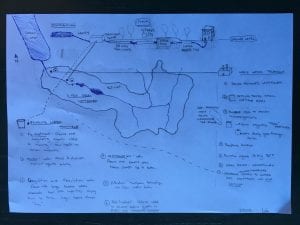By Lela Robinson
சிலநகரங்களில்நிலத்திற்குமேல்குழாய்கள்உள்ளன.
Silanagaramkalilnillatrumelkulaygul,
சிலநகரங்களில்கீழேகுழாய்கள்உள்ளன
Cilanagaramkalilkillaykulagulullana.
எல்லாநகரங்களுக்கும்செயல்முறைகள்உள்ளன
Ellānakaraṅkaḷukkumceyalmuṟaikaḷuḷḷaṉa.
Some cities have pipes above ground,
some cities have pipes below.
All cities have processes.

Networks embedded within the landscapes we live in provide insight into urban areas. Thirteen drawings of water and waste systems (eight in Indian villages and five in American cities and suburbs) illustrated not only the similarities and differences found in these networks, but also the physical processes which shape our lived environments. Together, the NFLC participants discussed each and every drawing, first in Tamil and then in English. The student drawn systems displayed a number of differences in both how water was collected and how it was distributed. Though not as evident in the drawings, our discussions revealed the most notable difference between the flows of water in India and the States. The network of pipes and drains running through our colleagues’ villages in India are above ground, a visible infrastructure which contributes to their image and knowledge base of their environment. The US has an extended network for water and waste below the surface of the earth, creating a concealed city of utilities. We faced our own ignorance in this exercise, realizing the extent to which we have become accustomed to a network of unobserved utilities. These basic utilities that we so often take for granted are an integral aspect of our everyday lives.
As a class we analyzed the similarities and differences in each drawing not only to cross the boundaries that separate us but also to better understand the processes which shape our lived environments. We learned how spatial collectives of concrete things and the processes, both human and physical, create each other and what we try and define as a city.

We touched upon the concept of desakota to understand urban clustering and settlements located between major cities. We looked at maps with urban settlements sprawled across, as southern India experiences significant small-city urbanization, both east to west from Chennai to Kozhikode, and along the Kerala coast. The pattern here is one among many across the globe illustrating the interactions between people, their m,ovement and urban economies developing under the influence of global and local forces.
After two days of class at Manda’arae we began to realize the paradox of administering cities as contained places despite the fact that they thrive and grow at a variety of scales. As an Urban Studies Major at Cornell, I have come to realize the irony of defining an urban area when trying to plan a city, an effort which expects established boundaries and processes. Sitting in a classroom in the small town of Kotagiri, Ihave begun to understand and internalize this dichotomy.

